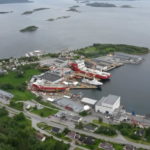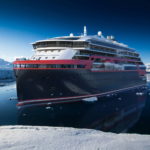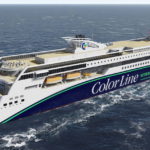
Norwegian shipyards that were primarily focused on vessels for the offshore service sector have to reshuffle their portfolios. There are promising alternatives, but only time will tell if they can make up for the loss of the offshore business. By Felix Selzer
The downturn in the offshore oi[ds_preview]l and gas market has hit the Norwegian economy hard. Rigs were shut down, workers and vessels were laid off, shipowners feel huge pressure for consolidation, and shipyards are suffering from a lack of new orders.
»The offshore market is practically non-existent at the moment,« Ellen Kvalsund, spokeswoman of Kleven shipyard, tells HANSA. For the last 20 years, almost all of the yard’s newbuildings were for the offshore industry and primarily for Norwegian shipowners. Ulstein, another important shipyard that was also focused on the Norwegian offshore platform supply and anchor handling vessel market, found itself in the same situation.
»The offshore service sector has been suffering badly,« says Vard’s Holger Dilling, EVP, Investor Relations & Business Development Asia, and he adds, »there is hardly any newbuilding activity – not out of Norway and not from anywhere else.« In fact, Vard has not sold any ship to the offshore industry since the end of 2015. Before that, around 80% of Vard’s deliveries were to the offshore sector.
A look at the reference lists of the Norwegian offshore shipbuilders like Vard, Ulstein, Kleven or Havyard, reveals how heavily – some might say madly – companies such as Island Offshore, Remøy Shipping, Rieber Shipping, Polarcus, Olympic Shipping, Solstad, Farstad, Eidesvik Offshore, Siem Offshore and others did order new vessels in the past. The lists also show how the ordering of Platform Supply Vessels (PSV), Seismic Vessels, Offshore Construction Vessels (OCV) and Anchor Handling Tug Suppliers (AHTS) has almost come to a full stop. International customers have stopped ordering new ships, too. Offshore oil and gas is down everywhere, not only in Norway.
Diversification and new segments
The shipbuilders had to look for alternatives, but where to turn to, when there are not many segments worldwide performing too well? Passenger shipbuilding is still going strong, the large shipyards in Italy, France, Germany, and Finland have full order books for the years to come as the cruise boom continues. Besides the big vessels, smaller units for exclusive exploration cruises are in demand – a profitable opportunity also for smaller yards. At the same time, record high salmon prices, a growing global demand for seafood and the need for fleet renewal make the fishing and aqua-farming segments attractive markets. It requires trawlers, Live Fish Carriers, Feed Carriers and installation vessels. Vard is actually branching out with one of its smaller yards in Norway to serve this segment.
For Vard, the exploration cruise segment has been a strong driver. »This segment has surprisingly many similarities to offshore shipbuilding,« says Dilling, meaning highly customized and specialized high-tech vessels in a size-class of 100 to 200m, partly constructed for operation in arctic areas. »These are characteristics you see in both offshore and exploration cruise.« As part of Italian shipbuilding giant Fincantieri Vard has a strong partner when it comes to acquiring new contracts and getting access to expertise and suppliers in this segment.
At the end of 2016, Vard’s order book comprised twelve offshore vessels, two LPG carriers, one fishing vessel and six exploration cruise ships. A Letter of Intent for a seventh cruiser was signed in early 2017 when Vard also secured contracts for two ferries, two fishing trawlers and one live fish transportation vessel. And there still are opportunities in the oil and gas market: For Dubai-based Topaz Energy and Marine and Kazakhstan’s Kazmortransflot Vard will build 20 Module Carriers (MCV) for the Caspian Sea to serve remote onshore oil fields in Kazakhstan. »This is an important order, but it is a niche opportunity and not necessarily a new market segment,« Dilling explains. 17 vessels will be for Topaz, while three will be for Kazmortransflot.
Ulstein, besides wind farm service and cruise ships, has turned to the RoPax market. Currently, Ulstein’s orderbook includes an offshore-design yacht for an undisclosed owner, due Q1 2018, and a 3,500 dwt DP2 Construction Support Vessel (CSV) for the Netherlands-based Acta Marine, primarily aimed at the offshore wind market, scheduled for delivery in Q2 2018. A plug-in hybrid RoPax ferry for operator Color Line at 4,000 dwt will be delivered in Q2 2019. In Q2 2017 the refurbishing of an exploration cruiser for Adventurers Partner will be finished.
Havyard’s order backlog at the end of 2016 included a Live Fish Carrier, a workboat and three diesel-electric ferries for Fjord 1. »All segments of the group need new order intake to fill capacities in 2017,« the shipyard says in its Q4 2016 report.
Kleven has the two cruise ferries for Hurtigruten in its orderbook (plus options for two more), scheduled for 2018 and 2019. The announcement of the Rolls-Royce-designed hybrid ice-class vessels has already raised eyebrows. Kleven will also deliver two ferries (2018), a Live Fish Carrier, a trawler and a fish harvesting vessel.
Strategy under review
The shipyards did also restructure their production to react to the downturn and to meet new demands. Kleven has automated and robotized its production process and has moved a larger part of the hull production back to Norway in recent years. »We have to adjust to whatever market is available, but it is challenging replacing the offshore market,« Ellen Kvalsund says. »There is a wide range of know-how needed that is specific to the vessel type in question, so we are expanding our expertise and knowledge.« Ulstein is confident to replace the offshore losses if the company can manage to keep costs down and to deliver cost effective solutions.
Vard started its strategy review two years ago, when it became visible that the market would stay down, and analysed its assets and capabilities. »We saw what was coming, but of course it did require changes in the organization«, says Dilling. Vard operates nine shipbuilding facilities worldwide, five in Norway, two in Romania, one in Brazil and one in Vietnam. As a consequence of the dramatic downturn in production volumes, the company had to let go close to 2,000 workers in their hull production facilities in Romania. »Now we are expanding again and hire and train people for our new shipbuilding segments,« says Dilling.
No bright future for offshore
Even if the offshore oil & gas market picks up again und pulls the service shipping sector up along, that will not immediately change things for the ship builders, maybe not even in the medium term. The order and delivery boom of the recent past has left the market with a huge supply of now unemployed but new and state-of-the-art ships. Hundreds of offshore service vessels are laid up worldwide, ports and berths along the Norwegian coast are crowded with 100–200 laid up platform suplliers. An upswing in the oil and gas market would certainly over time bring work for these existing ships, but large numbers of new orders are not to be expected anytime soon.
Wind power is another interesting market that can even use some of the offshore designs with some changes like adding walk-to-work gangways etc. »The market is still small and young,« notes Dilling. »But we are monitoring it carefully for opportunities.«
Other business areas might open up in segments like subsea mining, cable laying or offshore construction, oceanographic research, but as many shipyards previously focused on offshore are pushing into the same markets, competition is tough. At least the pressure might be a strong driver for further innovation.
Felix Selzer



















